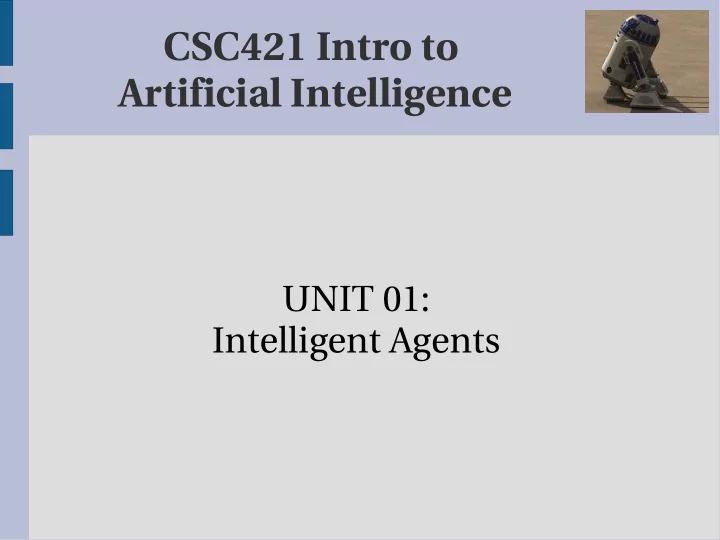

CSC421 Intro to Artificial Intelligence UNIT 01: Intelligent Agents
Agents & environments ● Examples of agents ?
Agents & environments Agents include humans, robots, softbots, thermostats etc The agent function maps from precept history to actions: f: P* -> A The agent program run on the physical architecture to produce f
The doughnut world A B Precepts: location and contents e.g [A, Doughnut] Actions : left, right, eat, NoOp
Doughnut Eating Agent (DEA) Precept Sequence Action [A, empty] Right [A, doughnut] Eat [B, empty] Left What is the “right” [B, doughnut] Eat function ? [A, empty], [A, empty] Right Can it be implemented [A, empty], [B, doughnut] Eat by a small agent program? ..... .... function RELFEX_DEA([location, status]) returns an action if status = Doughnut then return Eat else if location = A then return Right else if location = B then return Left
Rationality ● Fixed performance measure evaluates the environment sequence – One point per square cleaned in time T ? – One point per clean square per time step, minus one per move ? ● A rational agent chooses whichever action maximizes the expected value of the performance measure given the percept sequence to date ● Rational is not omniscient - percepts may not supply all relevant information
PEAS description ● Performance measure ● Environment ● Actuators ● Sensors
PEAS for ● Doughnut eating agent ? ● Automated taxi ? ● Internet shopping agent ? ● Non-player character in computer game ? ● Chess-playing program ?
Environments The environment type largely determines the agent design The real world is (of course) partially observable, stochastic, sequential, dynamic, continuous, multi-agent.
Agent types ● Four basic types in order of increasing complexity – Simple reflex agents – Reflex agents with state – Goal-based agents – Utility-based agents ● All these can be turned into learning agents
Simple reflex agents
Reflex agents with state
Goal-based agents
Utility-based agents
Learning Agents
Summary I ● Agents interact with environments through actuators and sensors ● The agent function describes what the agent does in all circumstances ● The performance measure evaluates the environment sequence ● A rational agent tries to maximize performance ● PEAS descriptions define task environments
Summary II ● Environments – Observable ? deterministic ? episodic ? static ? discrete ? single agent ? ● Agent architectures – Reflex – Reflex with state – Goal-based – Utility-based
Recommend
More recommend